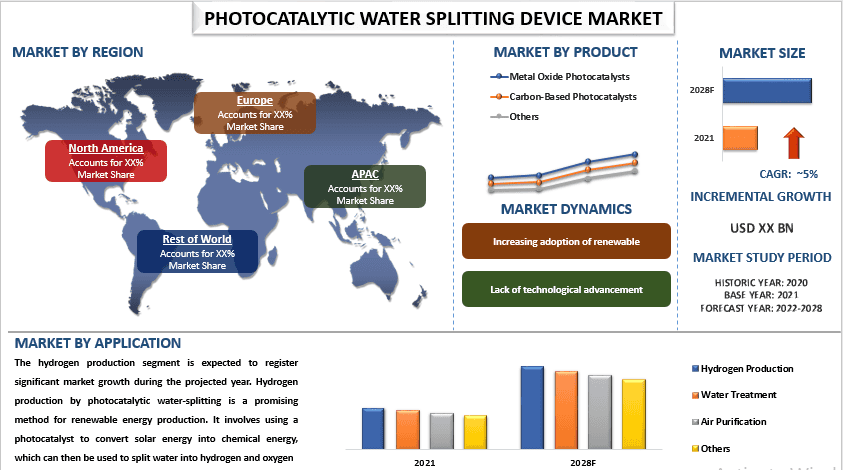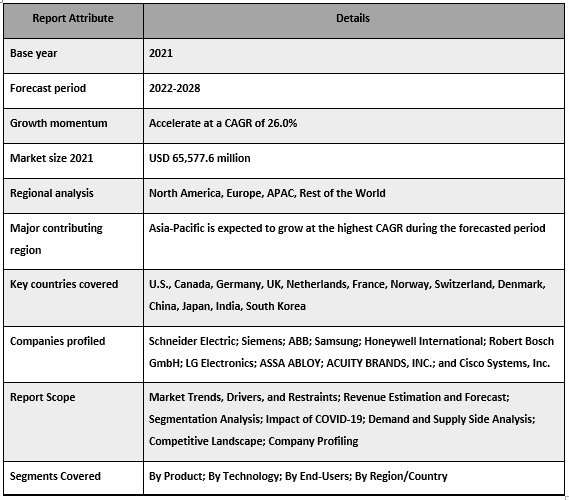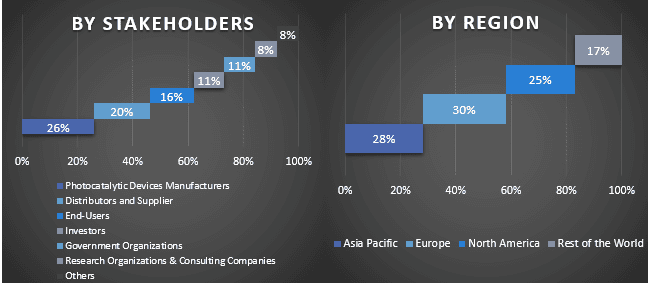- Inicio
- Acerca de nosotros
- Industria
- Servicios
- Leyendo
- Contáctenos
Mercado de dispositivos de división fotocatalítica de agua: Análisis actual y pronóstico (2022-2028)
Énfasis en el producto (fotocatalizadores de óxido metálico, fotocatalizadores a base de carbono y otros); Aplicación (producción de hidrógeno, tratamiento de agua, purificación de aire y otros); y Región/País

El mercado de dispositivos fotocatalíticos para la descomposición del agua se valoró en USD 65 577,6 millones en 2021 y se espera que crezca a una CAGR del 5,0% durante el período de pronóstico 2022-2028. El mercado de dispositivos fotocatalíticos para la descomposición del agua es una industria relativamente nueva y de rápido crecimiento, impulsada por la creciente demanda de fuentes de energía sostenibles y renovables. Los dispositivos fotocatalíticos para la descomposición del agua utilizan la energía solar para dividir las moléculas de agua en hidrógeno y oxígeno, que luego pueden utilizarse como combustible para diversas aplicaciones. El mercado de dispositivos fotocatalíticos para la descomposición del agua está actualmente dominado por Asia-Pacífico, con países como Japón, China y Corea del Sur a la cabeza en investigación y desarrollo. Sin embargo, también existe un importante potencial de crecimiento en otras regiones, como Europa y América del Norte, donde hay un creciente interés en las tecnologías de energía renovable. Se espera que el mercado de dispositivos fotocatalíticos para la descomposición del agua siga creciendo en los próximos años, a medida que los gobiernos de todo el mundo inviertan en energías renovables y a medida que la tecnología se haga más extendida y asequible. Sin embargo, todavía hay una serie de desafíos que deben abordarse, como el alto coste de producción y la necesidad de mejores catalizadores, antes de que los dispositivos fotocatalíticos para la descomposición del agua puedan convertirse en una fuente de energía convencional.
Algunos de los principales actores que operan en el mercado son Toyota Motor Corporation, Honda Motor Co., Ltd., Toshiba Corporation, Mitsubishi Electric Corporation, Panasonic Corporation, LARSEN & TOUBRO LTD, CASE GROUP, Linde plc, Fortescue Future Industries, Air Products. Estos actores han llevado a cabo varias fusiones y adquisiciones junto con asociaciones para facilitar a los clientes productos/tecnologías innovadores y de alta tecnología.
Perspectivas presentadas en el informe
"Entre los productos, el segmento de fotocatalizadores a base de carbono experimenta una importante CAGR del mercado en 2021".
Según el producto, el mercado se segmenta en fotocatalizadores de óxido metálico, fotocatalizadores a base de carbono y otros. Se espera que el segmento de fotocatalizadores a base de carbono experimente una importante CAGR durante el período de previsión. Los fotocatalizadores a base de carbono son materiales que están compuestos principalmente de carbono y son capaces de absorber la luz e iniciar reacciones químicas. Han ganado un interés significativo en los últimos años debido a sus propiedades únicas, como su alta estabilidad, baja toxicidad y capacidad de absorber la luz en el rango visible. Los fotocatalizadores a base de carbono tienen aplicaciones en campos como la producción de energía, la remediación ambiental y la ingeniería biomédica. Por ejemplo, pueden utilizarse para generar hidrógeno u otros combustibles a partir del agua o para descomponer contaminantes en el agua o el aire.
"Entre las aplicaciones, el segmento de producción de hidrógeno representó la mayor parte del mercado en 2021"
Por aplicación, el mercado se segmenta en producción de hidrógeno, tratamiento de agua, purificación de aire y otros. Se espera que el segmento de producción de hidrógeno registre un importante crecimiento del mercado durante el año proyectado. La producción de hidrógeno por división fotocatalítica del agua es un método prometedor para la producción de energía renovable. Implica el uso de un fotocatalizador para convertir la energía solar en energía química, que luego puede utilizarse para dividir el agua en hidrógeno y oxígeno. Existen varios tipos de fotocatalizadores que pueden utilizarse para la división del agua, incluidos los óxidos metálicos como el dióxido de titanio (TiO2), así como materiales a base de carbono como el grafeno y los nanotubos de carbono.
"Asia-Pacífico dominó el mercado de dispositivos fotocatalíticos para la descomposición del agua en 2021".
Asia-Pacífico dominó el mercado de dispositivos fotocatalíticos para la descomposición del agua en 2021 debido a la creciente demanda de soluciones de energía limpia y a la creciente preocupación por la escasez de agua. Además, el mercado de dispositivos fotocatalíticos para la descomposición del agua en la región de Asia-Pacífico está impulsado por varios factores, entre los que se incluyen la presencia de una gran población, la rápida industrialización y el aumento de las inversiones en fuentes de energía renovables. Además, se espera que las políticas e iniciativas gubernamentales favorables para reducir las emisiones de carbono impulsen aún más el crecimiento del mercado. Se espera que países como China, Japón y Corea del Sur sean los principales contribuyentes al crecimiento del mercado en la región de Asia-Pacífico. Estos países tienen importantes actividades de investigación y desarrollo en el campo de las energías renovables y han aplicado políticas y reglamentos favorables para promover la adopción de soluciones de energía limpia.
Cobertura del informe del mercado de dispositivos fotocatalíticos para la descomposición del agua

Razones para comprar este informe:
- El estudio incluye el dimensionamiento del mercado y el análisis de previsiones validados por expertos clave autentificados de la industria.
- El informe presenta una rápida revisión del rendimiento general de la industria de un vistazo.
- El informe cubre un análisis en profundidad de los principales pares de la industria con un enfoque principal en las finanzas clave del negocio, carteras de productos, estrategias de expansión y desarrollos recientes.
- Examen detallado de los impulsores, las restricciones, las tendencias clave y las oportunidades que prevalecen en la industria.
- El estudio cubre exhaustivamente el mercado a través de diferentes segmentos.
- Análisis profundo a nivel regional de la industria.
Opciones de personalización:
El mercado mundial de dispositivos fotocatalíticos para la descomposición del agua puede personalizarse aún más según los requisitos o cualquier otro segmento de mercado. Además de esto, UMI entiende que puede tener sus propias necesidades de negocio, por lo tanto, no dude en conectar con nosotros para obtener un informe que se adapte completamente a sus necesidades.
Tabla de contenido
Metodología de Investigación para el Análisis del Mercado de Dispositivos de División Fotocatalítica del Agua (2022-2028)
El análisis del mercado histórico, la estimación del mercado actual y la previsión del mercado futuro del mercado mundial de dispositivos de división fotocatalítica del agua fueron los tres pasos principales emprendidos para crear y analizar la adopción de dispositivos de división fotocatalítica del agua en las principales regiones del mundo. Se llevó a cabo una exhaustiva investigación secundaria para recopilar las cifras históricas del mercado y estimar el tamaño actual del mercado. En segundo lugar, para validar estos datos, se tomaron en consideración numerosos hallazgos y supuestos. Además, se realizaron exhaustivas entrevistas primarias con expertos de la industria en toda la cadena de valor del mercado mundial de dispositivos de división fotocatalítica del agua. Tras la suposición y validación de las cifras del mercado a través de entrevistas primarias, empleamos un enfoque de arriba hacia abajo/de abajo hacia arriba para pronosticar el tamaño total del mercado. Posteriormente, se adoptaron métodos de desglose del mercado y de triangulación de datos para estimar y analizar el tamaño del mercado de los segmentos y subsegmentos a los que pertenece la industria. A continuación se explica la metodología detallada:
Análisis del Tamaño Histórico del Mercado
Paso 1: Estudio en Profundidad de Fuentes Secundarias:
Se llevó a cabo un estudio secundario detallado para obtener el tamaño histórico del mercado de dispositivos de división fotocatalítica del agua a través de fuentes internas de la empresa, como informes anuales y estados financieros, presentaciones de resultados, comunicados de prensa, etc., y fuentes externas, incluyendo revistas, noticias y artículos, publicaciones gubernamentales, publicaciones de la competencia, informes sectoriales, bases de datos de terceros y otras publicaciones creíbles.
Paso 2: Segmentación del Mercado:
Después de obtener el tamaño histórico del mercado de dispositivos de división fotocatalítica del agua, realizamos un análisis secundario detallado para recopilar información histórica del mercado y la cuota de los diferentes segmentos y subsegmentos para las principales regiones. Los principales segmentos incluidos en el informe son el producto y la aplicación. Además, se realizaron análisis a nivel de país para evaluar la adopción general de modelos de prueba en esa región.
Paso 3: Análisis de Factores:
Después de adquirir el tamaño histórico del mercado de los diferentes segmentos y subsegmentos, realizamos un análisis de factores detallado para estimar el tamaño actual del mercado de dispositivos de división fotocatalítica del agua. Además, realizamos un análisis de factores utilizando variables dependientes e independientes, como el producto y la aplicación del mercado de dispositivos de división fotocatalítica del agua. Se llevó a cabo un análisis exhaustivo de los escenarios de la demanda y la oferta, teniendo en cuenta las principales asociaciones, fusiones y adquisiciones, la expansión empresarial y los lanzamientos de productos en el sector del mercado de dispositivos de división fotocatalítica del agua en todo el mundo.
Estimación y Previsión del Tamaño Actual del Mercado
Tamaño Actual del Mercado: Basándonos en la información práctica obtenida en los 3 pasos anteriores, llegamos al tamaño actual del mercado, los actores clave en el mercado mundial de dispositivos de división fotocatalítica del agua y las cuotas de mercado de los segmentos. Todos los porcentajes de cuota requeridos, la división y el desglose del mercado se determinaron utilizando el enfoque secundario mencionado anteriormente y se verificaron a través de entrevistas primarias.
Estimación y Previsión: Para la estimación y previsión del mercado, se asignaron ponderaciones a diferentes factores, incluyendo los impulsores y las tendencias, las restricciones y las oportunidades disponibles para las partes interesadas. Después de analizar estos factores, se aplicaron las técnicas de previsión pertinentes, es decir, el enfoque de arriba hacia abajo/de abajo hacia arriba, para llegar a la previsión del mercado para 2028 para los diferentes segmentos y subsegmentos en los principales mercados a nivel mundial. La metodología de investigación adoptada para estimar el tamaño del mercado abarca:
- El tamaño del mercado de la industria, en términos de ingresos (USD) y la tasa de adopción del mercado de dispositivos de división fotocatalítica del agua en los principales mercados a nivel nacional
- Todas las cuotas porcentuales, divisiones y desgloses de los segmentos y subsegmentos del mercado
- Los principales actores en el mercado mundial de dispositivos de división fotocatalítica del agua en términos de productos ofrecidos. Además, las estrategias de crecimiento adoptadas por estos actores para competir en el mercado de rápido crecimiento
Validación del Tamaño y la Cuota de Mercado
Investigación Primaria: Se realizaron entrevistas en profundidad con los Líderes de Opinión Clave (KOLs), incluyendo a los Ejecutivos de Alto Nivel (CXO/VPs, Jefe de Ventas, Jefe de Marketing, Jefe de Operaciones, Jefe Regional, Jefe de País, etc.) en las principales regiones. Los resultados de la investigación primaria se resumieron y se realizó un análisis estadístico para demostrar la hipótesis planteada. Los datos de la investigación primaria se consolidaron con los resultados secundarios, convirtiendo así la información en conocimientos prácticos.
División de los Participantes Primarios en Diferentes Regiones

Ingeniería de Mercado
Se empleó la técnica de triangulación de datos para completar la estimación general del mercado y para llegar a cifras estadísticas precisas para cada segmento y subsegmento del mercado mundial de dispositivos de división fotocatalítica del agua. Los datos se dividieron en varios segmentos y subsegmentos después de estudiar varios parámetros y tendencias en las áreas del producto, la tecnología y los usuarios finales en el mercado mundial de dispositivos de división fotocatalítica del agua.
El Objetivo Principal del Estudio del Mercado Mundial de Dispositivos de División Fotocatalítica del Agua
Las tendencias actuales y futuras del mercado mundial de dispositivos de división fotocatalítica del agua se identificaron en el estudio. Los inversores pueden obtener información estratégica para basar su discreción para las inversiones en el análisis cualitativo y cuantitativo realizado en el estudio. Las tendencias actuales y futuras del mercado determinaron el atractivo general del mercado a nivel regional, proporcionando una plataforma para que el participante industrial explote el mercado sin explotar para beneficiarse de una ventaja de ser el primero en actuar. Otros objetivos cuantitativos de los estudios incluyen:
- Analizar el tamaño actual y previsto del mercado de dispositivos de división fotocatalítica del agua en términos de valor (USD). Además, analizar el tamaño actual y previsto del mercado de los diferentes segmentos y subsegmentos
- Los segmentos en el estudio incluyen áreas del producto y la aplicación.
- Definir y analizar el marco regulatorio para el dispositivo de división fotocatalítica del agua
- Analizar la cadena de valor involucrada con la presencia de varios intermediarios, junto con el análisis del comportamiento de los clientes y la competencia de la industria
- Analizar el tamaño actual y previsto del mercado de dispositivos de división fotocatalítica del agua para la región principal.
- Los principales países de las regiones estudiadas en el informe incluyen Asia Pacífico, Europa, América del Norte y el Resto del Mundo
- Perfiles de las empresas del mercado de dispositivos de división fotocatalítica del agua y las estrategias de crecimiento adoptadas por los actores del mercado para mantenerse en el mercado de rápido crecimiento.
- Análisis regional profundo de la industria
Relacionados Informes
Los clientes que compraron este artículo también compraron










